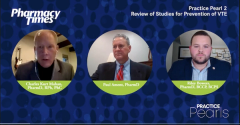
Practice Pearl 2: Review of Studies for Prevention of VTE
Paul Ament, PharmD, reviews the data from studies looking into the prevention of VTEs and Riley Bowers, PharmD, shares the real-world data to the studies.
Episodes in this series

Charles Kurt Mahan, PharmD, RPh, PhC: Let’s shift to looking at the preventive studies with VTE [venous thromboembolism], such as the MAGELLAN trial, the MARINER trial, the ADOPT trial, and the APEX trial, but with more of a focus on the FDA-approved agents because that’s more helpful.
Paul Ament, PharmD: What I would like to do, from a historical perspective, is include what’s called the EXCLAIM study with enoxaparin. It showed a significant reduction—I think there was a 38% risk reduction in clotting events. However, there was a significant increase in major bleeding, intracranial bleeding, and even fatal bleeding, so enoxaparin never went down the road of FDA approval. That has set the foundation for extended prophylaxis guidelines to not even recommend it based on enoxaparin.
Apixaban has been looked at with 2.5 mg twice a day. They were shown to be noninferior to the Lovenox [enoxaparin] arm, but there was a 2½-fold higher incidence of major bleeding with the apixaban arm. The MAGELLAN study, which is the rivaroxaban arm at 10 mg once daily, showed a 23% risk reduction. But their bleeding end points included a composite of major bleeding and clinically relevant nonmajor bleeding at 2½ times, and they did not go after the indication.
However, there was a subgroup analysis that was recently published, and they looked at 5 high-risk bleeding groups, including those with various pulmonary issues, such as pulmonary cavitation and pulmonary hemorrhage. They looked at patients who were undergoing active cancer inpatient treatments, which is very rare. They also looked at patients who had a gastroduodenal bleed in the last 3 months, major bleeding in the last 3 months, or dual antiplatelet therapy. When they excluded those patients out of the study, they then went back and submitted to the FDA, and they obtained the FDA approval. Some have argued that it really wasn’t a clinical study; it was retrospective data mining, but the FDA approved them, so we can use that at 10 mg once daily.
The APEX study was interesting. It was with betrixaban, and this study did not meet its end point. There were some unique statistical outcomes looking at exploratory data analysis, but the FDA-approved betrixaban did not meet its end points. That dose is 160mg on day 1 followed by 80mg on subsequent days, and it is indicated to 42 days. With rivaroxaban, the indication extends to 39 days.
We recently had the MARINER trial that used a different outcome. They went out to 45 days. They used the validation score of the IMPROVE VTE Risk Calculator to risk-stratify their patients. They did not enroll patients until discharge, so that teased out some of the high-risk bleeding. What they used was symptomatic VTE as their outcome where all the other studies used a composite of asymptomatic and symptomatic clots.
To summarize, we have 2 products, betrixaban and rivaroxaban, that are FDA approved to be used for extended therapy, but the treatment guidelines have not adopted them into their pathways.
Charles Kurt Mahan, PharmD, RPh, PhC: What are your thoughts on this? There’s a bit of a separation between what we need to do in real practice and the guidelines. The FDA’s move to approve betrixaban, for instance, was with good data, but there is not always a great gate. Sometimes, it’s not always the P value. If it’s a P value of .0051 or.49, it’s trending in the right direction, for instance. Could you comment?
Riley Bowers, PharmD, BCCP, BCPS: In practice, I don’t feel like betrixaban ever caught on. If COVID-19 [coronavirus disease 2019] has done anything for the anticoagulation world, we’re starting to see some extended prophylaxis, especially with rivaroxaban in our high-risk patients. In the practice realm, it’s still few and far between when we see that extended prophylaxis, but with the data, if you dig into it, especially in those subset analyses, when you start pulling out those very high-risk patients who we mentioned when we were talking about our scoring systems, those are going to be your patients who may be your best candidates for this extended VTE prophylaxis.
Charles Kurt Mahan, PharmD, RPh, PhC: That’s a great point. That’s my feeling as well. Even though the data are not perfect and the guidelines aren’t all perfect, it’s clear with the number of VTE cases that we have that doing nothing with extended thromboprophylaxis is somewhat negligent. We have to at least try to identify the highest-risk patients who aren’t at risk for bleeding and do something to prophylax those patients.
Newsletter
Stay informed on drug updates, treatment guidelines, and pharmacy practice trends—subscribe to Pharmacy Times for weekly clinical insights.














































































































































































































